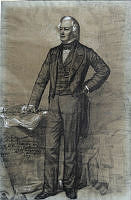Commodore Uriah P. Levy, White House Collection
This silhouette made of cut paper with a charcoal background is of Commodore Uriah P. Levy and was done by Augustin-Amant-Constant-Fidèle Edouart, also known as Auguste Edouart. The full-body silhouette features Levy holding a telescope and looking out over stormy waters, including a boat being tossed about and fortifications along the shore. Levy was the first Jewish Commodore in the U.S. Navy and fought in the Barbary Wars and the War of 1812. Before joining the Navy, he volunteered with the Philadelphia militia in the American Revolution. Silhouette portraits were fashionable and readily available throughout Europe and the United States in the 1800s.

